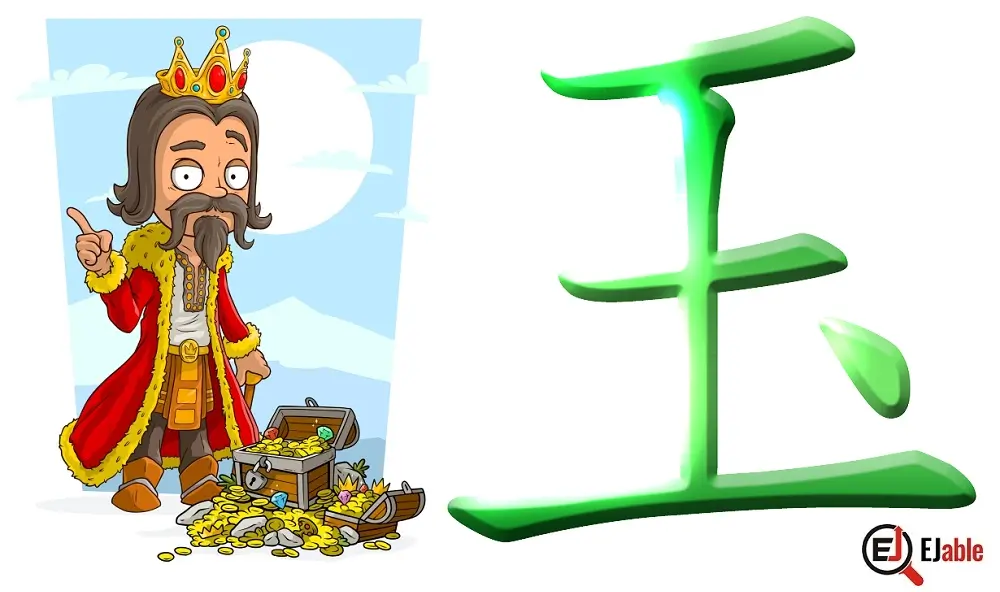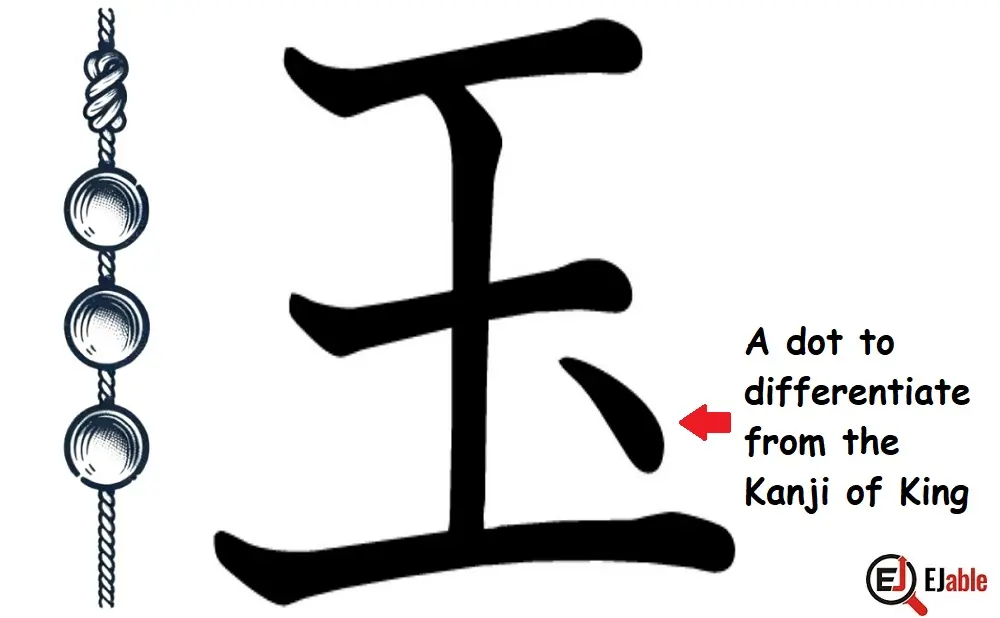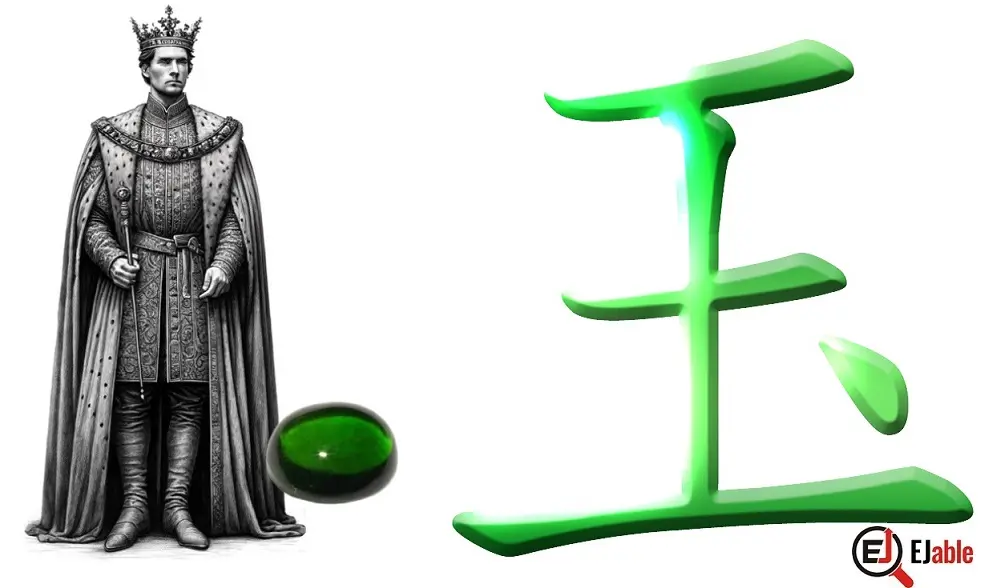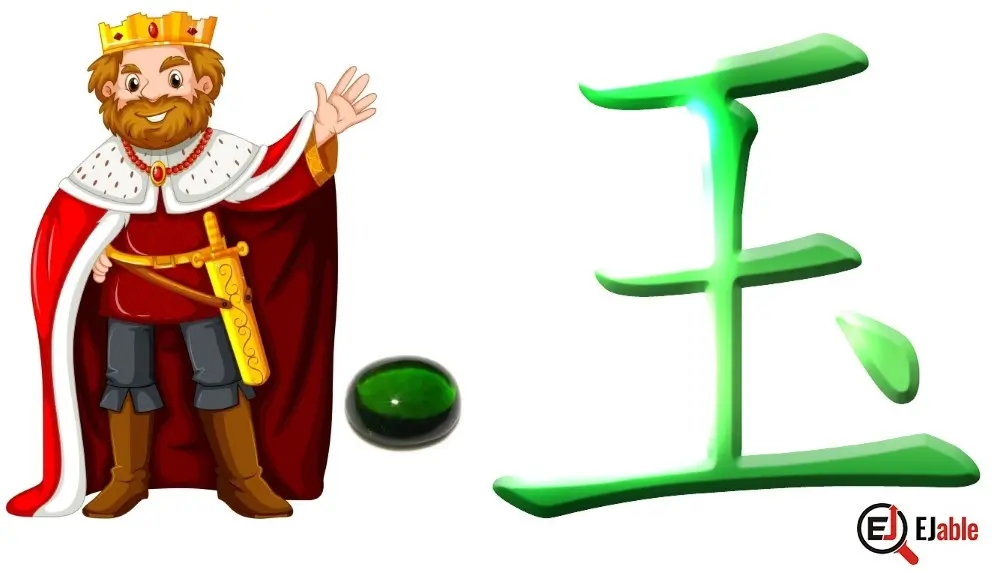Kanji for “Jade,” “Jewel” and Sometimes “Ball”: 玉 (Tama, Gyoku)

In Japanese, the Kanji for “jade” is 玉. The Kunyomi, or the Japanese, pronunciation of the Kanji 玉 is tama (たま), and the Onyomi (Chinese) pronunciation is gyoku (ギョク) or goku (ゴク).
However, there’s another less common Kanji 瑚 (ko), which can refer to “coral” and is sometimes associated with precious stones like jade in a broader sense. 瑚, in specific contexts, it may imply a precious stone similar to jade, but its primary and common usage is more aligned with coral.
The use of 瑚 as a representation of jade is much less direct and common compared to 玉. Generally, when referring to jade in Japanese, 玉 is the predominantly used Kanji.
Jade’s Kanji is part of JLPT N2 and is taught in grade 1 in Japanese schools.
Construction and Origin of Jade’s Kanji 玉


The Kanji for Jade 玉 originally depicted a string of three jewels with a knot at the top. This reflects jade’s ancient use as ornaments and ceremonial objects. This Kanji was later simplified as three horizontal lines joined by a vertical line at the center. However, the resultant shape represents the Kanji for King. Therefore, a small dot was added over the bottom horizontal line on the right-hand side.
The construction of the Kanji 玉 has 5 strokes.
Jade’s Association with Royalties
Jade holds significant cultural value in East Asian societies, symbolizing purity, beauty, and moral integrity. This cultural reverence is embedded in the Kanji 玉.
Apart from many other cultures, Jade has long been associated with Chinese culture. Chinese people considered Jade an “Imperial Gem.” Therefore, apart from ornaments, jade was used to create many objects associated with royal ceremonies and utilities.
Historically, in Japanese culture, jade symbolized power and wealth, which are closely associated with royalty. The traditional belief of Japanese people is that green Jade represents the life and soul of the earth, and Jade is the national stone of Japan.
Mnemonic: How to Remember the Kanji 玉 for Jade
It is very easy to remember the Kanji for Jade by using the mnemonic of Jade’s association with royalties or kings. The prerequisite for it is to first know the King’s Kanji.
Considering the above, the following illustration will serve as a good mnemonic to remember Jade’s Kanji:


If you do not like the seriousness of the above illustration, you may picture the association of Jade’s Kanji with the king in the following picture:


Other meanings of the Kanji of Jade
While primarily representing jade, 玉 is also used more broadly to denote precious stones or gems in general.
Metaphorically, 玉 can symbolize something precious or beautiful, often used in names and literature.
Extension of Jade’s Kanji to Represent a Ball
Over time, the meaning of 玉 expanded beyond jade to include spherical objects, like balls. This extension likely came from the round shape of many jade ornaments.
There is another Kanji specifically used for “ball,” which is 球 (pronounced “kyū” in Japanese). This Kanji is more commonly and specifically associated with the concept of a ball, particularly in sports and scientific contexts.
For example, it’s used in words like 野球 (やきゅう / yakyū) for “baseball,” 足球 (さっきゅう / sakkyū) for “football” or “soccer,” and even in scientific terms like 地球 (ちきゅう / chikyū) for “earth” or “globe.” This Kanji, unlike Jade’s Kanji 玉, is more explicitly linked to spherical objects and is the more precise term when referring to balls in a sporting or scientific context.
In contrast, Jade’s Kanji 玉 (gyoku) represents a ball primarily in a traditional or classical context, often referring to older or more historical types of balls.
For example, it might describe the round, jewel-like balls used in traditional games or ceremonies. This usage tends to be more poetic or artistic, reflecting the Kanji’s origin in representing something precious like jade. The use of 玉 for “ball” reflects the Kanji’s broader symbolic association with round, precious objects.
Jade’s Kanji as a Radical
The Kanji for Jade 玉 appears as a radical or subcomponent in 20 Kanji characters, including 4 Jōyō Kanji.
However, as mentioned in our guide to common Kanji radicals, the radical for the Kanji characters of Jade and King is the same and commonly appears as 王 (King). This can lead to confusion; however, we should relate both Kanji characters to represent royalty and beauty in such contexts.
Following are the examples where the Kanji of Jade appears as a Kanji radical or bushu:
- 珍 (ちん / chin): Precious, rare.
- 球 (きゅう / kyū): Sphere, ball.
- 環 (かん / kan): Ring, circle.
- 瑞 (ずい / zui): Auspicious.
- 班 (はん / han): Group, squad.
- 琴 (きん / kin): Koto (a traditional Japanese stringed musical instrument).
- 瑠 (る / ru): Lapis lazuli.
- 璽 (じ / ji): Imperial seal.
- 瑛 (えい / ei): Crystal clear.
- 璃 (り / ri): Glass, crystal.
- 琢 (たく / taku): Polish (jewels).
- 琉 (りゅう / ryū): Glass, glazed.
- 瑶 (よう / yō): Beautiful jade.
These characters incorporate the 玉 radical and convey meanings often related to preciousness, beauty, or roundness, reflecting the properties and cultural significance of jade.
Compound Words with the Kanji for Jade
There are 99 Japanese words that begin with the Kanji for Jade 玉, and it appears in 274 words. Following are the examples of such compound words:
- 玉石 (ぎょくせき / gyokuseki): Jade and other precious stones.
- 玉手箱 (たまてばこ / tamatebako): Treasure box, often in fairy tales.
- 宝玉 (ほうぎょく / hōgyoku): Jewel, gem.
- 水晶玉 (すいしょうだま / suishōdama): Crystal ball.
- 玉座 (ぎょくざ / gyokuza): Throne (poetically).
- 玉子 (たまご / tamago): Egg (literally “jewel child”).
- 玉葱 (たまねぎ / tamanegi): Onion (literally “jewel vegetable”).
- 玉米 (ぎょくべい / gyokubei): Corn (literally “jewel rice”).
- 金玉 (きんぎょく / kingyoku): Testicles (colloquially, literally “gold jewels”).
- 玉竜 (ぎょくりゅう / gyokuryū): A type of ornamental plant (literally “jewel dragon”).
These compound words showcase the diverse use of 玉 in Japanese, extending from literal references to jade and precious stones to more metaphorical and idiomatic expressions.
Check other Kanji characters on the page “How to Remember Kanji“. You may also like to read about the common Kanji radicals.


A long-term ex-pat in Japan, Himanshu comes with an IT background in SAP consulting, IT Business Development, and then running the country operations of an IT consulting multinational. Himanshu is the co-founder and Managing Director of ReachExt K.K. and EJable.com. He is also an Advisory Board Member of a Silicon Valley AI/IoT startup.

